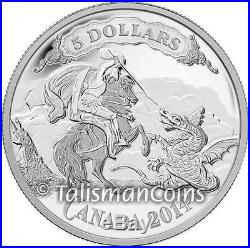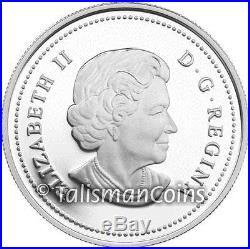


The timeless, classic St. George slaying the dragon! This beauteous, low mintage (only 8,500) proof represents a tremendous investment opportunity – stuck in pure silver! Talisman Coins and the Royal Canadian Mint are proud to bring you this second in the new. Canadian Banknote Art program. This expertly crafted, pure silver. Proof is a stunning and unique tribute an early allegorical bank note. This is the second coin in the Royal Canadian Mint’s exciting new series celebrating vignettes found on historic Canadian banknotes. These incredible scenes are the high artwork of yesteryear! The RCM’s traditional engraving has reproduced this art this time in precious metals, not paper! These scenes are highly detailed, with various finishes used to create texture and contrast on a mirrored background. All this makes this low-mintage. Proof a must-have work of art for any history buffs, lovers of beauty, and coin and banknote. Masterpiece of the Minter’s Art – A Classical, Allegorical Design. Design of this fine silver. Vignette from the original 1859 Bank of Western Canada banknote depicting an armored Saint George, cape flowing dramatically behind him, astride his rearing horse. The spear he clutches in his raised right hand is held high above his feathered helmet as he prepares to slay the dragon. George’s horse is fearless and brave, its front right leg pawing forcefully at the dragon. The intricately scaled dragon sits beneath St. Its sharp fangs and forked tongue bared as its sharply clawed forelimbs reach for the knight. Its webbed wings and curled snakelike tail are rendered in breathtaking detail by Royal Canadian Mint engravers. To the left sits a stark and barren tree stump. The stump, along with the desolate, contrasting shadows rendered with skillful artistry at the horse’s feet, nods at the story’s setting. In an ornate frame derived from scroll work appearing on the original banknote. The image is surmounted by the face value 5 DOLLARS. Please see the articles lower in this presentation for more information and history about the original banknote. This is the second issue in the new precious metals program. Featuring incredibly intricate, traditional designs. This beauty, with its very affordable price and very limited mintage of only 8,500, seems destined to sell out quickly! Get this first ever Banknotes Art silver proof while you can! The Legend of St. Saint George, the patron saint of England, is a Christian martyr who is believed to have lived in the late 3rd and early 4th centuries A. The famous legend of St. George slaying the dragon. Tells of a plague-bearing dragon, a hideously evil monster. The townsfolk of Silene would feed it sheep to appease it, but soon they ran out of sheep. In desperation, they turned to sacrificing their children to the dragon, and drew lots to determine which would die. The day came when the King’s own daughter was among the young girls selected for death. Dressed as a bride for the wedding she would never know, the royal Princess was led to her doom, certain to be devoured by the ravenous dragon. Unbeknownst to the people, a knight named George had heard of this scourge and had set out on a quest to find and slay this beast in the name of God. He came upon the dragon just as it was about to eat the young girls. Surprising it on horseback, he killed it with his lance, saving the princess and freeing the entire kingdom. The King, in his gratitude, built a church on the site of the dragon’s demise and converted to Christianity. The legend of the knightly. And thereby saving the kingdom and its princess, dates to medieval times, with origins lost in the mists of history. The sword with which St. George slew the dragon is traditionally named called. (which recalls the city of Ashkelon, in the Middle East, and which figures in the legend). Not coincidentally, Prime Minister Winston Churchill named the airplane he used personally during World War II “Ascalon”. George is the patron saint of England, so when the Pistrucci was called upon for a design for the Gold Sovereign. His inspired genius and superb artistry produced the gold beauty we so admire today, and the rest, as they say, is history. This gold sovereign contains exactly 113 grains 7.322 g or. 2354 troy ounces of pure gold, as sovereigns have for the past two hundred years. George Slaying the Dragon – The Sovereign Design and Its Designer. Pistrucci created the famous St. George & the Dragon design used on British gold sovereigns. And crowns first seen during the Great Recoinage of 1816. He cut the dies for the coinage from 1817; the crowns were issued in 1818, 1819 and 1820. Pistrucci’s involvement with the coinage ceased in 1825 but he continued at the Mint until 1849 as a medalist. He also engaged in private work as a cameo- and intaglio-maker, commanding high prices for his work, and turned out the occasional bust. George Slaying the Dragon. Pistrucci’s other masterpiece is undoubtedly the massive 140.8 mm, 677.5 g Waterloo Medal, which took over 30 years to complete! The Royal Canadian Mint refines the purest silver in the world. The RCM is also the only mint in the world to issue commemorative coins in a. Coin is 99.99% pure! An allegorical scene depicts the knight. The date and denomination are both indicated. Her Majesty, Queen Elizabeth II. In profile facing right. This portrait, the fourth effigy of the queen to appear on Canadian coinage, was executed by the artist Susanna Blunt. The legend ELIZABETH II D. REGINA (“Elizabeth II, Queen by the Grace of God”) also appears. The coin is encapsulated inside a burgundy leatherette, clamshell-style presentation case, lined with black velvet and protected by a full color outer box. An individually-numbered certificate of authenticity is included. 9999 Fine (Pure) Silver. Royal Canadian Mint engravers. Charting the Course of Banking in Canada. The story of banking in Canada reflects the nation’s unique history. As it evolved from colony to Dominion to independent state, Canada was uniquely positioned to draw from the systems and experience of both Britain and the United States, in order to ultimately build a system entirely its own. This process was rarely smooth. Marked from its earliest stages by rigorous debate about who should control such processes as issuing banknotes, for instance, Canada’s fledgling banking system represented a complex interplay of commercial and political interests at home and abroad. The earliest chartered banks of deposit and issue in Canada were granted charters relatively late in the colony’s history-in the early 1820s. These institutions were governed largely by their charters. As the nation changed over the decades that followed, becoming united in a single Province of Canada in 1841 and emerging as a Dominion following Confederation in 1867, banking and its associated practices were increasingly constrained by national and provincial legislation rather than solely by individual bank charters. 1859 Bank of Western Canada Banknote. The 1859 Bank of Western Canada banknote upon which this coin design is based was issued by a short-lived chartered bank based in the region that is now Niagara Falls, Ontario. Said to have been established in 1859 by an American tavern owner, the Bank of Western Canada had its charter revoked, to considerable scandal, on October 15, 1863, alongside several other banks that had also become insolvent. The incident formed part of a pattern at the time that had greatly eroded public faith in chartered banks’ notes. Notorious “wildcat” banks like the Bank of Western Canada were in the business of issuing notes they knew they could never redeem. Outcry arose over the ease with which chartered banks could thus dupe the public with worthless paper. This outcry fed national momentum toward gold-backed government-issued notes, a practice that began with Provincial notes in 1866 and Dominion notes following Confederation. Employing Art to Outsmart Counterfeiters. Thus by the mid 1800s note engraving and design had become a major business. Examining a bank note from nearly any nation will reveal several design elements that emerged in the nineteenth century, including the use of line engraving and the presence of portraiture, allegorical imagery, complex calligraphic lettering, and complicated geometric patterns. American Jacob Perkins is credited with popularizing this composite approach in 1799 with his patented stereotype steel plates that combined engraved portraits, vignettes (pictorial and allegorical images), words, and geometric lines on a banknote to create a composition whose complexity made it essentially impossible for counterfeiters to reproduce it. Saint George Slaying the Dragon. Though the Bank of Western Canada did not survive long, the iconic image of Saint George slaying the dragon that appears on this note has roots that go back thousands of years. At the time of the note’s issuance, Saint George had been present on popular British gold sovereigns since 1817. The sovereign design, by famed medalist Benedetto Pistrucci, featured a caped Saint George on a rearing horse slaying a dragon at his feet and became so iconic that it may have influenced the America Bank Note Company artist who designed the vignette on this note. Though the Saint’s origins are ancient and murky, the version of the Saint George story that had become popular by the nineteenth century centered on a horseman traveling through Libya. Happening upon a young girl tied to a stake near a swamp, he learns of a terrible dragon that has been tormenting the local people. Though they had offered the monster sacrifices of sheep to appease it, it continued its relentless torment. In a final attempt to save themselves, the people had chosen to sacrifice the King’s daughter. When the dragon inevitably appears, he is laid low by Saint George, who uses the girl’s girdle, or garter, to bind it and lead it into the city, where it is destroyed, tamed, or converted according to various traditions. The element of the princess’s garter may historically be associated with the Order of the Garter established during the Crusades, of which Saint George is patron. Regardless of the historical accuracy of the story, Saint George’s iconography of chivalry has remained consistent since the Middle Ages. Saint George the Dragon Slayer, with his red cross on white background, was made the patron saint of England in the 1340s by Edward III. Since that time, the saint has featured prominently in the works of many of the western world’s most noted artists. Saint George remained a popular figure on British medallions and coinage throughout the nineteenth century and was thus a fitting candidate for depiction on Canadian banknotes such as this one issued by the Bank of Western Canada in 1859. Talisman World Coins and Medals has been in business for more than 20 years and is one of the largest world coin direct distributors and wholesalers in the world. The item “Canada 2014 Canadian Banknote #2 Saint George Slaying Dragon $5 Silver Proof” is in sale since Saturday, November 09, 2013. This item is in the category “Coins & Paper Money\Coins\ Canada\Commemorative”. The seller is “talismancoins” and is located in Saint Louis, Missouri. This item can be shipped worldwide.
- Circulated/Uncirculated: Uncirculated
- Country of Manufacture: Canada
